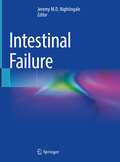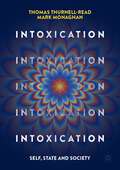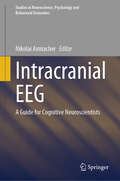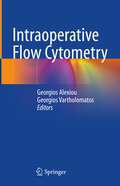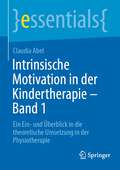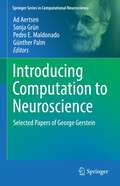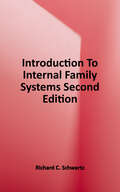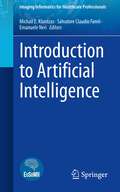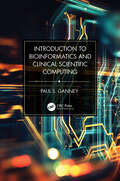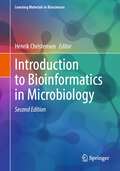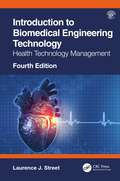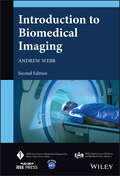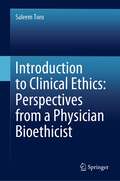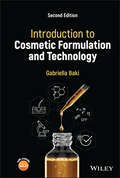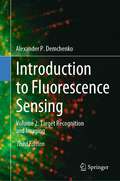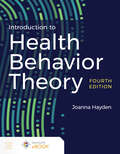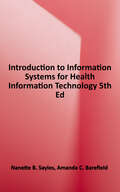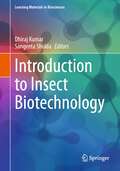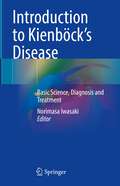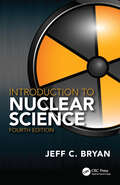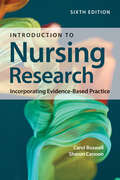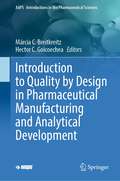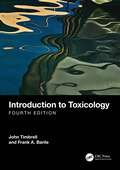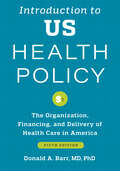- Table View
- List View
Intestinal Failure
by Jeremy M. D. NightingaleThis is the second and fully updated edition of the successful volume on intestinal failure in adults and children. The book provides a comprehensive coverage of all aspects of intestinal failure: from acute and chronic intestinal failure management and treatment, to outcomes, consequences and problems of treatment. In addition, 20 new chapters have been added, covering acute and chronic pancreatitis, critical care and abdominal pain among other topics. Each of the chapters contains a section with top tips on the topic, summarizing the essential take-home messages. Highly educational, this book is a must have for gastroenterologists but is of use for all members of a hospital nutrition support team including nurses, dietitians and pharmacists, whom it will serve as a practical guide for management of intestinal failure both in the hospital and in an outpatient setting. Written by a multidisciplinary author team, this book brings this important subject to a wide readership. With extensive referencing the book provides a detailed overview of the topic, discussing the latest research in the subject and how this relates to current clinical practice and potential future treatments.
Intimate Strangers: Commercial Surrogacy in Russia and Ukraine and the Making of Truth
by Veronika SieglZooming in on commercial surrogacy in Russia and Ukraine, Intimate Strangers addresses market expansion into the intimate spheres of life that play out on women's bodies as mothers and workers. Veronika Siegl follows the inner workings of a surrogacy market marked by secrecy, distrust, and anonymous business relationships. She explores intended mothers' anxious struggles for a child in light of stigmatized infertility and the aggressive biopolitics of motherhood; the uncertain but pragmatic pathways in and out of fertility clinics as surrogates navigate harsh economic realities and resist being objectified or morally judged; and the powerful role of agents and doctors who have found a profitable niche in nurturing and facilitating other people's existential hopes. Intimate Strangers discusses these issues against the backdrop of ultra-conservatism and moral governance in Russia, the rising international popularity of the Ukrainian surrogacy market, and the pervasiveness of neo-liberal ideologies and individualized notions of reproductive freedom.
Intoxication: Self, State and Society
by Thomas Thurnell-Read Mark MonaghanWhat images come to mind when you read the word ‘intoxication’? What behaviour do you associate with the word ‘drunk’? When you hear the word ‘drug’, what images do you recall? This textbook provides an essential and thorough grounding in debates about the role of intoxication in contemporary society, from social and cultural perspectives. It examines intoxication in the broadest sense as including both legal and illegal substances and both culturally accepted and socially stigmatised practices. Given the pace of recent changes in policy and practice – from the increasingly common legalisation of cannabis, to the recent trend of sobriety amongst adolescents and young adults – this book stands out by offering both a through historical and theoretical overview and a topical and forward looking exploration of current debates. It adopts a multi-scale approach to examine wider patterns of change so it considers the subjective experiences of the role intoxication plays in the lives of individuals and groups, in the construction of diverse identities and how this differs by age, gender and ethnicity. The authors play particular attention to the way in which the state justifies interventions based on moral, health and criminal justice discourses and also consider the role played by other individuals and institutions, not least the mass media and the alcohol industry, in propagating and challenging common sense explanations of intoxication. It speaks to undergraduates, master's students and above, with a range of pedagogic features, and offers insights into policy and practice.
Intracranial EEG: A Guide for Cognitive Neuroscientists (Studies in Neuroscience, Psychology and Behavioral Economics)
by Nikolai AxmacherThis book offers the first, comprehensive guide to planning and conducting intracranial EEG studies, and analyzing intracranial EEG data. The chapters address core questions in the field of intracranial EEG research. They are written by internationally recognized experts in the domain of intracranial EEG and acknowledge the heterogeneity of approaches in this field. The particular format of the book allows readers to find clear guidelines, hands-on expertise and invaluable background information for planning and conducting state-of-the-art intracranial EEG research projects. Besides offering a reference guide to newcomers in the field, it also provides scholarly information for the more experienced researcher and inspiration for the expert. The book covers a wide range of topics, with a special emphasis on aspects in which intracranial EEG data differ from other types of data in the cognitive neurosciences. It discusses typical patient characteristics and implantation schemes, ethical issues, and practical considerations for planning and running intracranial EEG experiments. It addresses signal characteristics and the physiological background of oscillatory and non-oscillatory aspects of intracranial EEG signals. It describes complex pre-processing steps such as advantages and disadvantages of different referencing schemes, and how to identify the location of electrodes. In addition, it answers specific questions on data processing, addressing core aspects of statistical analysis, and suggesting guidelines for data presentation. Further, it covers advanced topics such as causal interventions (i.e. deep brain stimulation), acquisition and analysis of single-unit data and multimodal recordings, and discusses important future challenges and opportunities in the field of intracranial EEG research.
Intraoperative Flow Cytometry
by Georgios Alexiou Georgios VartholomatosThis book describes intraoperative flow cytometry in solid tumours. Intraoperative flow cytometry is an innovative technique for assessing tumour margins and grade of malignancy intraoperatively. The authors have been working on this procedure for more than 14 years and have introduced it in the surgery of intracranial tumours, breast cancer, liver cancer and head and neck neoplasms, as described in the book. A detailed description of the main pathological findings will be followed by an explanation of the intraoperative flow cytometry’s role. In each chapter, information will be provided to stimulate further research on this topic. The book will also include new topics that have not been published till now. The book is aimed at neurosurgeons, general surgeons, ENT specialists, breast surgeons, radiologists, pathologists, oncologists, biologists, biochemists and scientists working with on flow cytometry.
Intrinsische Motivation in der Kindertherapie - Band 1: Ein Ein- und Überblick in die theoretische Umsetzung in der Physiotherapie (essentials)
by Claudia AbelKinder mit motorischen Einschränkungen haben häufig langjährigen Therapiebedarf. Das optimale Outcome der Therapie wird nur möglich, wenn die jungen Patient*innen motiviert und begeistert bei der Sache bleiben. Claudia Abel liefert mit diesem essential über die intrinsische Motivation in der Kindertherapie Fakten, um den Therapieverlauf durch den Erhalt der Motivation des Kindes zu unterstützen. Je nach Alter und Entwicklungsphase des Kindes kann die Therapiesituation individuell auf das Kind abgestimmt und angepasst werden.
Introducing Computation to Neuroscience: Selected Papers of George Gerstein (Springer Series in Computational Neuroscience)
by Günther Palm Sonja Grün Ad Aertsen Pedro E. MaldonadoThis book brings together a selection of papers by George Gerstein, representing his long-term endeavor of making neuroscience into a more rigorous science inspired by physics, where he had his roots. Professor Gerstein was many years ahead of the field, consistently striving for quantitative analyses, mechanistic models, and conceptual clarity. In doing so, he pioneered Computational Neuroscience, many years before the term itself was born. The overarching goal of George Gerstein’s research was to understand the functional organization of neuronal networks in the brain. The editors of this book have compiled a selection of George Gerstein’s many seminal contributions to neuroscience--be they experimental, theoretical or computational--into a single, comprehensive volume .The aim is to provide readers with a fresh introduction of these various concepts in the original literature. The volume is organized in a series of chapters by subject, ordered in time, each one containing one or more of George Gerstein’s papers.
Introduction To Internal Family Systems
by Richard C. SchwartzA highly accessible introduction to a therapeutic approach that brings our inner “parts” into harmony and allows our core Self to lead We’re all familiar with self-talk, self-doubt, and self-judgment―yet most of us still view ourselves as if we have one uniform mind. Dr. Richard Schwartz’s breakthrough was recognizing that we each contain an “internal family” of distinct parts―and that treating these parts with curiosity, respect, and empathy vastly expands our capacity to heal. Over the past two decades, Internal Family Systems (IFS) has transformed the practice of psychotherapy. With Introduction to Internal Family Systems, the creator of IFS presents the ideal layperson’s guide for understanding this empowering, effective, and non-pathologizing approach to self-discovery and healing. Here, Dr. Schwartz shares evidence, case studies, and self-care tools to help you: - Shift from the limiting “mono-mind” paradigm into an appreciation of your marvelous, multidimensional nature - Unburden your wounded parts from extreme beliefs, emotions, and addictions - Demystify the most commonly misunderstood parts―the Exiles, Managers, and Firefighters - Transform your most challenging parts from inner obstacles to invaluable allies - Embrace the existence of innate human goodness―in yourself and others - Connect with the true Self that is greater than the sum of your parts “The most wonderful discovery I have made is that as you do this work, you release, or liberate, what I call your Self or your True Self―the calm, compassionate essence of who you are,” says Dr. Schwartz. “When the Self becomes the leading intelligence in our lives, we create more harmony―both within ourselves and in our external lives.” For therapists, their clients, and anyone interested in understanding and healing themselves, here is an essential guide to a revolutionary approach to self-realization, mental wellness, and transformation.
Introduction to Artificial Intelligence (Imaging Informatics for Healthcare Professionals)
by Emanuele Neri Michail E. Klontzas Salvatore Claudio FanniThis book aims to provide physicians and scientists with the basics of Artificial Intelligence (AI) with a special focus on medical imaging. The contents of the book provide an introduction to the main topics of artificial intelligence currently applied on medical image analysis. The book starts with a chapter explaining the basic terms used in artificial intelligence for novice readers and embarks on a series of chapters each one of which provides the basics on one AI-related topic. The second chapter presents the programming languages and available automated tools that enable the development of AI applications for medical imaging. The third chapter endeavours to analyse the main traditional machine learning techniques, explaining algorithms such as random forests, support vector machines as well as basic neural networks. The applications of those machines on the analysis of radiomics data is expanded in the fourth chapter to allow the understanding of algorithms used to build classifiers for the diagnosis of disease processes with the use of radiomics. Chapter five provides the basics of natural language processing which has revolutionized the analysis of complex radiological reports and chapter six affords a succinct introduction to convolutional neural networks which have revolutionized medical image analysis enabling automated image-based diagnosis, image enhancement (e.g. denoising), protocolling etc. The penultimate chapter provides an introduction to data preprocessing for use in the aforementioned artificial intelligence applications. The book concludes with a chapter demonstrating AI-based tools already in radiological practice while providing an insight about the foreseeable future. It will be a valuable resource for radiologists, computer scientists and postgraduate students working on medical image analysis.
Introduction to Bioinformatics and Clinical Scientific Computing
by Paul S. GanneyThis textbook provides an introduction to computer science theory, informatics best practice, and the standards and legislation that apply to computing in a healthcare environment. It delivers an accessible discussion of databases (construction, interrogation and maintenance); networking (design and low-level application); programming (best practice rather than the specifics of any one language – design, maintenance, safety). It can be used to accompany the NHS Modernising Scientific Careers syllabus. It is also targeted towards those creating software rather than those using it, particularly computer scientists working in healthcare, specifically those in or close to the Physical Sciences, including radiotherapy, nuclear medicine, and equipment management and those working with genomics and health informatics.
Introduction to Bioinformatics in Microbiology (Learning Materials in Biosciences)
by Henrik ChristensenThis updated and extended second edition of the textbook introduces the basic concepts of bioinformatics and enhances students' skills in the use of software and tools relevant to microbiology research. It discusses the most relevant methods for analysing data and teaches readers how to draw valid conclusions from the observations obtained. Free software and servers available on the Internet are presented in an updated version of 2023 and more advanced stand-alone software is proposed as a second option. In addition, new tools for microbial genome analysis and new flowcharts that complement the didactic elements have been added. Exercises and training questionnaires are included at the end of each chapter to facilitate learning. The book is aimed at Ph.D. students and advanced undergraduate students in microbiology, biotechnology, and (veterinary) medicine with little or basic knowledge of bioinformatics.
Introduction to Biomedical Engineering Technology, 4th Edition: Health Technology Management
by Laurence J. StreetThis updated fourth edition provides current information on devices and is divided into diagnostic and treatment sections. Devices are described with the theory of operation and relevant anatomical and physiological considerations. Aspects of BMET work including test equipment, standards, and information technology are also discussed. The text covers a wide variety of diagnostic and treatment devices currently used in hospitals that students will likely encounter in their career. Principles of operation and examples of use are provided. This book is unique in that it is written by an experienced biomed tech with 30 years’ experience in hospitals rather than by engineers with little frontline experience. It is also unique in that it provides ancillary materials on the web and is the only guide divided into diagnostic and treatment device sections. This new edition also includes two new chapters on computers, information technology, and networking as well as health technology management. From the previous edition: "The book presents a comfortable balance between clinical applications, basic technical information, and various pictures of medical technologies one will encounter in the field. Additionally, related anatomy and physiology principles and essential technical terms are a nice complement to the technologies presented. The everyday duties and responsibilities of a biomed are captured by the various ‘true-to-life’ scenarios introduced throughout the book." —Joey Jones, Madisonville Community College, Kentucky, USA This book is intended for students in biomedical engineering technology and healthcare technology management (BMET/HTM) programs as well as biomedical engineering students. Field service representatives, medical device designers, and medical device sales representatives will also find it useful.
Introduction to Biomedical Imaging: Physics, Engineering And Clinical Applications (IEEE Press Series on Biomedical Engineering)
by Andrew WebbIntroduction to BiomedicalImaging A state-of-the-art exploration of the foundations and latest developments in biomedical imaging technology In the newly revised second edition of Introduction to Biomedical Imaging, distinguished researcher Dr. Andrew Webb delivers a comprehensive description of the fundamentals and applications of the most important current medical imaging techniques: X-ray and computed tomography, nuclear medicine, ultrasound, magnetic resonance imaging, and various optical-based methods. Each chapter explains the physical principles, instrument design, data acquisition, image reconstruction, and clinical applications of its respective modality. This latest edition incorporates descriptions of recent developments in photon counting CT, total body PET, superresolution-based ultrasound, phased-array MRI technology, optical coherence tomography, and iterative and model-based image reconstruction techniques. The final chapter discusses the increasing role of artificial intelligence/deep learning in biomedical imaging. The text also includes a thorough introduction to general image characteristics, including discussions of signal-to-noise and contrast-to-noise. Perfect for graduate and senior undergraduate students of biomedical engineering, Introduction to Biomedical Imaging, 2nd Edition will also earn a place in the libraries of medical imaging professionals with an interest in medical imaging techniques.
Introduction to Clinical Ethics: Perspectives from a Physician Bioethicist
by Saleem ToroThis textbook offers an introduction to the field of bioethics, specifically from a practicing physician standpoint. It engages a wide range of recent scholarship and emerging research covering many crucial topics in clinical ethics. While there has been increasing attention to the role of bioethics in medicine, the gap between theory and practice still exists, and it continues to impede the dialogue between health care professionals from one side and bioethicists and philosophers of medicine from the other side. This book builds bridges and open channels of connection between different parties in these conversations. It does so from a physician’s practical perspective, engaging recent scholarship and emerging research, to shed light on pivotal ethical dilemmas in contemporary clinical practice.
Introduction to Cosmetic Formulation and Technology
by Gabriella BakiIntroduction to Cosmetic Formulation and Technology An accessible and practical review of cosmetics and OTC drug-cosmetic products In the newly revised second edition of Introduction to Cosmetic Formulation and Technology, veteran educator and researcher Dr. Gabriella Baki delivers a comprehensive discussion of cosmetics and personal care products, including coverage of basic concepts, ingredient selection, formulation technology, and testing. The book offers a clear and easy-to-understand review of cosmetics and over the counter (OTC) drug-cosmetic products available in the United States. In this latest edition, the author expands on general concepts and adds brand-new chapters on the basics of cosmetics testing, ingredients, and skin lightening products. Each chapter includes a summary of common abbreviations with questions provided online, alongside a solutions manual for instructors. Readers will also find: A thorough introduction to the basic definitions, claims, and classifications of cosmetics and OTC drug-cosmetic products Comprehensive explorations of the current rules and regulations for cosmetics and OTC drug-cosmetic products in the United States and European Union Detailed review of cosmetic ingredients, functions, and typical uses both in a dedicated a chapter and included within various others Practical coverage of good manufacturing practices for cosmetics, including documentation, buildings and facilities, equipment, and personnel Fulsome review of a variety of skin and hair care products, color cosmetics, and other personal care products Perfect for undergraduate and graduate students studying cosmetic science in chemistry, chemical engineering, pharmaceutical, biomedical, and biology departments, Introduction to Cosmetic Formulation and Technology will also benefit cosmetic chemists, cosmetic product formulators, cosmetic scientists, quality control managers, cosmetic testing specialists, and technicians.
Introduction to Fluorescence Sensing: Volume 2: Target Recognition and Imaging
by Alexander P. DemchenkoFluorescence is the most popular technique in chemical and biological sensing because of its ultimate sensitivity, high temporal and spatial resolution and versatility that enables imaging within the living cells. It develops rapidly in the directions of constructing new molecular recognition units, new fluorescence reporters and in improving sensitivity of response up to detection of single molecules. Its application areas range from control of industrial processes to environment monitoring and clinical diagnostics. This book provides systematic knowledge of basic principles in design of fluorescence sensing and imaging techniques together with critical analysis of recent developments. Being a guide for students and young researchers, it also addresses professionals involved in active basic and applied research. Making a strong link between education, research and product development, this book discusses prospects for future progress.
Introduction to Health Behavior Theory
by Joanna HaydenDesigned to provide students with an easy to understand, interesting, and engaging introduction to the theoretical basis of health education, Introduction to Health Behavior Theory, Fourth Edition uses comprehensive and accessible explanations to help students understand what theory is, how theories are developed, and what factors influence health behavior theory. Covering the more commonly used health behavior theories in individual chapters, the author breaks each theory into concepts and constructs to enhance comprehension and encourage students to discover how these theories can be put into practice. Theory essence sentence and constructs chart at the beginning of each chapter condenses the theory into one easy to learn and remember sentence and provides context for the rest of the chapter.A historical overview of each theory's development provides students with a context for how and why the theory explains behavior.Numerous examples from the literature in difference practice settings with different populations to support learning/understanding of the content. Many examples are COVID-19 related.End of chapter activities based on a reproduced full journal article reinforce chapter content by clearly demonstrating the theory's application in practice.Links to and annotations of additional open access articles in each chapter that demonstrate the application of the theory in practice.A final summary chapter includes guidelines for choosing a theory, summary charts of theory essence sentences and constructs, and construct domains with examples of corresponding program activities.Navigate eBook access (included with the print text) provides online or offline access to the digital text from a computer, tablet, or mobile device. Introduction to Health Education and Health Promotion Health Behavior Theory Health Behavior Change Social and Behavioral Aspects of Health Principles of Health Education Health Education Theory and Practice Health Education Theories and Techniques © 2023 | 320 pages
Introduction to Information Systems for Health Information Technology, 5th Edition
by Nanette B. Sayles Amanda C. BarefieldHealth information management (HIM) students and professionals must learn everything they can about the basics of electronic health records (EHRs), general healthcare computer systems, data retrieval, and other EHR system topics. This text helps readers gain an understanding of how these systems and issues affect, and are affected by, the HIM profession. Updated to reflect current information technology (IT) content in the healthcare environment relevant to both scholars and professionals, this fifth edition of Introduction to Information Systems for Health Information Technology explains the growing wealth of health data and information available to HIM practitioners and what it can do for patients and society, while also explaining the responsibility to secure these assets. This edition emphasizes practical applications within the HIM profession, offering revised real-world scenarios and practice opportunities. Key Features: - New online student workbook - Real-World Cases and Check Your Understanding questions in each chapter - Updated privacy and security information and best practices
Introduction to Insect Biotechnology (Learning Materials in Biosciences)
by Dhiraj Kumar Sangeeta ShuklaThis textbook introduces to the fundamentals and applications of insect biotechnology in a concise manner. Global economically important insects such as silkworm, lac or honey bee are in the focus of this text. The book attempts to address all of the latest developments in this growing field such as application of metagenomics and proteomics in mining for genes and enzymes that could be beneficial in diverse industrial and biomedical applications. Further, insects have been established as suitable tool for the production of transgenic products which is discussed in one dedicated chapter. The book targets students and researchers in molecular biology, biotechnology or entomology who want to get familiar with the emerging field of insect biotechnology.
Introduction to Kienböck’s Disease: Basic Science, Diagnosis and Treatment
by Norimasa IwasakiThis book covers the pathogenesis, etiology, diagnosis and treatment options for avascular necrosis of the lunate, offering readers a systematic overview of Kienbock’s disease. Each chapter shares scientific findings and abundant illustrations on the latest advances in the diagnosis and treatment of the disease. Although some factors are known to be associated with this condition, there are no conclusively verified causes or standard treatment. This book provides an essential basis for new approaches and further research into this largely unexplained condition. Accordingly, it offers a valuable resource for hand and orthopedic surgeons, clinical residents and medical students seeking a thought-provoking, instructive and informative read.
Introduction to Nuclear Science
by Jeff C. BryanWritten to provide students who have limited backgrounds in the physical sciences and math with an accessible textbook on nuclear chemistry and physics, Introduction to Nuclear Science, Fourth Edition continues to provide a clear and complete introduction to nuclear chemistry and physics, from basic concepts to nuclear power and medical applications. Incorporating suggestions from adopting professors and collaborations with the U.S. Department of Energy-funded and American Chemical Society-sponsored Nuclear Chemistry Summer School, a new chapter on nuclear structure is now included. Also new to this edition: A section covering mass excess calculations Isochron dating of rocks The section on statistics is completely re-written to better align with conventional instruction Expanded discussion of recent changes in the nuclear power industry and nuclear medicine This book covers energetics, nuclear stability and structure, radioactive decay and reactions, interactions of radiation with matter, detection methods, and safety measures, including monitoring and regulations. This updated, expanded edition provides a much-needed textbook and resource for undergraduate students in science and engineering as well as those studying nuclear medicine and radiation therapy.
Introduction to Nursing Research: Incorporating Evidence-Based Practice
by Carol Boswell Sharon CannonIntroduction to Nursing Research: Incorporating Evidence-Based Practice, Sixth Edition provides a solid foundation for teaching and learning the basics of evidence-based practice. Giving students the tools they need to become effective practitioners, this text is a comprehensive guide for integrating evidence-based practice and research into the day-to-day work of nursing. Mastery of research will allow students training to be nurses to provide quality patient care and improve healthcare outcomes overall. As in previous editions, the authors take a thoughtful and practical approach by combining research, quality improvement, and evidence-based practice. The Sixth Edition focuses on the connection between research and evidence-based practice as a foundation for safe and effective health care. Demonstrating research establishes a foundation that will lead students to evidence-based practice. Includes coverage of Inter-professional education (IPE) and team research featuring activity and research examples Discusses COVID-19 in the context of conducting research during a pandemic The impact of predatory journal publishing in literature reviews Explores the most current research tools and methods for EBP Discusses the IOM's Future of Nursing report and the ACA recommendations as they relate to nursing and healthcare Covers cultural diversity and the global aspects of nursing research Nursing Research Research & Theory © 2023 | 450 pages
Introduction to Quality by Design in Pharmaceutical Manufacturing and Analytical Development (AAPS Introductions in the Pharmaceutical Sciences #10)
by Márcia C. Breitkreitz Hector C. GoicoecheaWritten by twenty-five authors from academia, pharmaceutical industry and Pharmacopeias worldwide, this monograph covers the fundamentals and applications of Quality by Design (QbD) and Analytical Quality by Design (AQbD) in a practical and didactic manner. The book starts by describing the motivation and the urgent need for the implementation of the QbD framework in pharmaceutical development, along with the definition of its major elements: Quality Target Product Profile (QTTP), Critical Quality Attributes (CQAs), Critical Process Parameters (CPPs), Critical Material Attributes (CMAs) and the importance of using multivariate methods of Design of Experiments (DOE). The concept of life cycle and regulatory perspectives are discussed. Three chapters are entirely dedicated to DOE theory from screening to optimization designs. Moreover, a comprehensive discussion on modelling and data treatment is presented. Practical aspects of QbD and DOE for pharmaceutical product and process of different dosage forms is included, as well as a practical guide of the input process variables, material attributes, intermediate, and final quality attributes for the most representative pharmaceutical processes. Analytical Quality by Design (AQbD) is also deeply explored, including risk analysis, definitions of Analytical Target Profile (ATP), Method Operable Design Region (MODR) and the life cycle approach, taking into account the compendial and regulatory perspectives. A detailed example of a new chromatographic method for the quality control of a pharmaceutical topical product based on the AQbD procedure is shown. Finally, advanced statistical approaches and DOE methods for extraction studies of bioactive compounds are also presented. The vast amount of information offered in this book provides a comprehensive perspective on QbD, AQbD and DOE principles, essential tools for modern pharmaceutical and analytical development.
Introduction to Toxicology
by Frank A. Barile John TimbrellAs with the previous editions, Introduction to Toxicology, Fourth Edition, continues to chart the evolution of the field of toxicology, from the use of natural toxins by ancient tribes through the developments established by Paracelsus, and progresses through to the current topics in the public interest. For centuries, the study of toxicology has fascinated students. The book begins with basic toxicological principles, including an historical summary, dose-response relationships (NEW chapter), exposure-response relationships (NEW chapter), disposition, and metabolism of xenobiotic toxic substances. Other important new chapters include target organ toxicity, toxicity of carcinogenic agents and new and updated concepts in toxicity testing, and antidotes and treatment of poisonings. In all, nine new or expanded chapters from the third edition are advanced. Current concerns about the effects of therapeutic drugs, carcinogens, industrial toxins, pesticides, and herbicides on human health, animal welfare, and the stability and maintenance of the ecosystem continue to highlight toxicology as an important and growing scientific discipline. Key features: Comprehensive coverage of the field of toxicology which illustrates its importance to and impact on society Uses pertinent examples, tables, and diagrams to aid understanding with learning objectives, summaries, questions, and answers for each chapter Clearly and concisely written and presented concepts for easy comprehension by toxicology, biomedical, and health science students Examines the complex interactions associated with toxicological events Covers the effect of toxins on biological and physiological systems This book successfully condenses the diffuse literature in the field into an accessible and readable text, made easier with the insertion of many tables and figures. It introduces fundamental concepts and builds upon these using topical and relevant historical examples. Its improved format includes learning objectives and summaries of each chapter, as well as questions and answers suitable for self-assessment. This latest edition is an invaluable resource for undergraduate and graduate toxicology students, as well as an introductory text for other health care students and professionals. The book also functions as a comprehensive introductory reference text for environmental scientists, medical biologists and chemists, chemical engineers, and regulatory agencies, with interests in toxicologically related areas.
